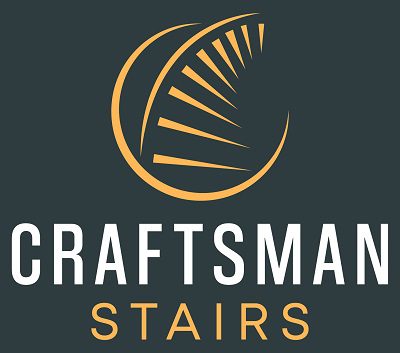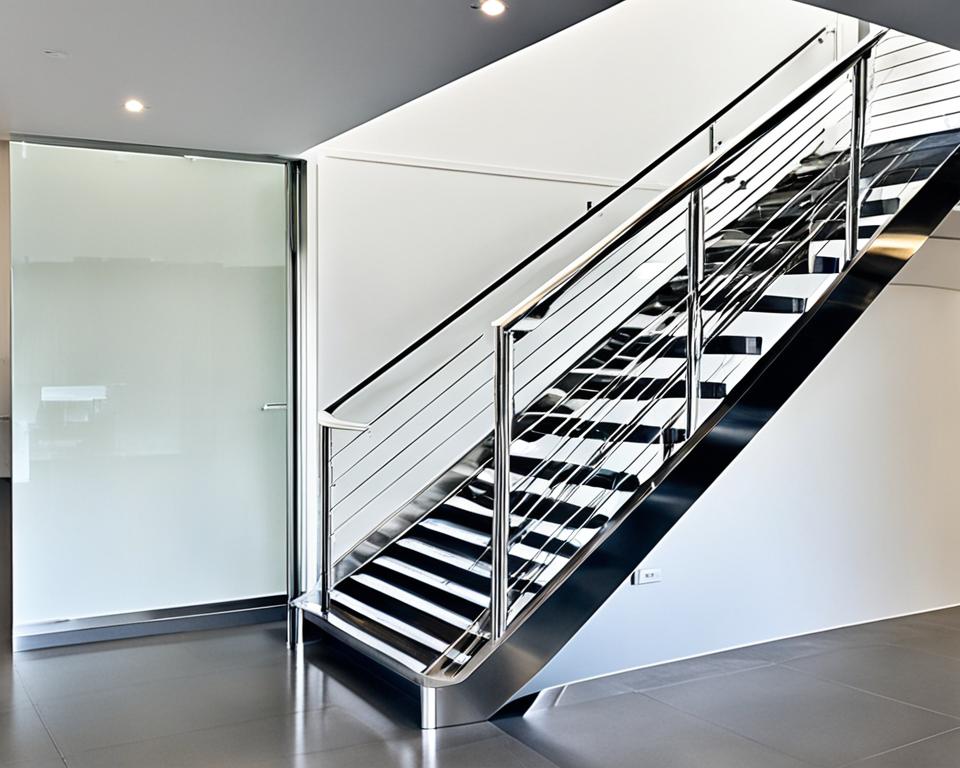Have you thought about how crucial staircase regulations compliance in QLD is? It’s key for safety and avoiding legal trouble.
This guide is essential for following Queensland’s staircase rules. It highlights the need to meet building codes in Queensland and stick to stair safety norms. The Australian Standards 1655 (2018) and the Managing the Work Environment and Facilities Code of Practice 2011 are vital references. They stress the need for consistent riser and going sizes, ensuring stairs are designed within the recommended slope range.
Stairs must fit certain requirements. They need at least 2 risers and no more than 18 risers without a 750mm² rest area. The width should be at least 600mm between handrails. They must have a slope angle of 26.5 to 45 degrees. Safety handrails and balustrades are critical too. Balustrades should stop a 125mm sphere from going through openings. They are needed where there could be a fall of 1000mm or more.
Keeping up maintenance and visibility is key. Adding non-slip surfaces and contrasting nosing can make stairs safer and lessen accident risks. Following these standards is crucial not just for safety. Not following them can mean big fines and legal issues, so compliance is a must.
Uniform size and specific measurements are vital for safety. Stairways need at least 2000mm of vertical clearance. Risers and goings must be consistent within ±5mm. The focus on these rules highlights the importance of proper tread width and the right dimensions for different types of rooms.
By following this guide’s advice, your staircases will not just meet but exceed stair safety standards. This makes sure everyone is in a safer environment.
Understanding the Fundamentals of Staircase Design
It’s key to design stairs by following Queensland’s standards for everyone’s safety. This means getting the measurements and materials right. By doing this, we make sure all stairs, whether they’re in homes or businesses, are safe and legal.
Key Dimensions and Measurements
In Queensland, there are strict rules for staircase dimensions to keep people safe. The rules cover the riser height and the length of the stair, sticking to standards set by AS1657. Stairs must have the same riser and tread sizes, within a 5 mm difference. No staircase should have more than 18 or fewer than 2 steps in a series.
This rule helps make sure that every step on a staircase is the same height and depth. Keeping a uniform design is crucial both in houses and commercial buildings. It’s all about making stairs predictable to prevent trips and falls.
Material Requirements and Standards
Staircase materials in Queensland need to be strong and prevent slipping. The AS1657 standard calls for tread and nosing edges that don’t let you slip. For very tall stairs, solid treads are a must. No mesh or holes are allowed because it’s all about keeping everyone safe, especially on high stairs.
Handrails and balustrades need careful planning too. The space between balusters has to be less than 125 mm to keep people, especially kids, safe. Good lighting and clear visibility are also needed to make stairs both safe and nice to look at. Following building codes and getting the right permits confirm that the stairs meet all safety standards.
So, designing stairs in Queensland really means focusing on safety, materials, and following the law. It’s about combining what works best with what’s legally required.
Handrails and Balustrades: Safety and Compliance
In Queensland, keeping staircases safe means following strict rules on handrails and balustrades. They are crucial for stopping accidents and injuries. This is especially so due to the area’s weather and the common issues with decks.
Handrail Specifications
Handrails are a must for any stairway wider than 1000mm in Queensland. They need to be 900mm to 1100mm high from the ground or stair treads. They should be easy to hold and have a gap of at least 50mm from walls or structures.
Also, it’s important to use materials that stand out to help prevent slips.
Balustrade Requirements
For decks or balconies over one meter high, a balustrade is needed. It must be at least one meter tall. The gaps in the balustrades can’t be more than 125mm. This rule is to keep kids safe.
Balustrades also have to be strong enough to handle wind or people leaning on them.
Installation Guidelines
Putting in handrails and balustrades has to follow the National Construction Code (NCC) Parts 3.9.1 and 3.9.2, and they need to meet AS 1657 standards. Making sure they are installed right is key to safety. Inspections ensure everything is up to code to prevent any structural issues.
Decks built before the 1940s need extra checks for any weak spots. Following these safety rules is vital to avoid serious accidents and to make sure buildings are up to Queensland’s standards.
Lighting and Visibility Standards for Stairs
In Queensland, it’s important to keep stairs safe and open for everyone. This means following strict rules for lighting and visibility. It’s essential to avoid accidents and help people with disabilities use the stairs safely.
Natural and Artificial Lighting
Stairwells need to be well-lit to be safe. The Aussie standard, AS/NZS 1680.1, lays out the lighting needs. Stairwell lighting requirements aim to get rid of shadows and bright spots. Using both sunlight and lights makes sure stairs are clear day and night. In case of a blackout, emergency lights should be near exit doors.
Work areas need a brightness of 160 lux. Areas used for walking should have at least 40 lux of light. This helps everyone move safely through these spaces.
Visual Cues and Contrasts
For better safety, stairs should have visual hints. Using different colours on the edge of each step and handrails helps a lot. These changes make stairs easier to see and follow disability access regulations stairs. It’s best to avoid busy patterns and aim for strong contrasts in colors. Keeping the lighting system in good shape is key.
Following these safety and lighting rules makes stairs safer for all. It also meets Queensland’s legal standards.
Ensuring Anti-Slip Measures and Tread Safety
is key. AS 4586: 2013 and AS 4663: 2013 demand slip-resistant stair treads to reduce accidents. Using non-slip finishes or non-slip strips on the nosing is crucial for safety.
It’s important to regularly check, upkeep, and fix stairs. This maintains safety and meets laws on safe stairs. It ensures stairs are safe for everyone, including those with disabilities.
Stairs must have certain sizes. Rises and goings need to be nearly the same within ±5 mm. The rise should be 130 to 225 mm and the going 215 to 355 mm. Proper landings, handrail heights, and lighting make stairs safer. Following these rules, like Australian Standard AS1657, makes stairs safer for all.
Staircase Regulations Compliance QLD: Legal Requirements and Consequences
It’s essential to follow the staircase regulations in QLD to keep people safe. The rules specify the size limits for the rise (130mm to 225mm) and the going (215mm to 355mm) of each step. They also require steps to be even, slip-proof, and well-lit, according to AS1657 (2018) and AS 1428:2010.
Handrails are vital for stair safety. They need to be placed at a height of 900mm to 1100mm above the steps or floor. If a stairway is over 1000mm wide, handrails must be on both sides. Regular checks and upkeep are necessary, following AS/NZS 1170.1 to prevent any dangers.
If you don’t stick to these rules, the consequences can be serious. You might face big fines, have to make changes, or be liable if an accident happens. Using QBCC-approved builders ensures your stairs are up to code. Following these laws ensures everyone’s safety on the stairs.
FAQ
Q: What are the key dimensions and measurements for staircase design in Queensland?
A: In Queensland, the design of staircases follows key dimensions like riser height and going length. These must meet AS1657 requirements. It’s vital to keep all risers and goings uniform within a ±5 mm tolerance for safety and compliance.
Q: What material requirements and standards must be adhered to for staircases?
A: Stair treads and nosing edges need to be slip-resistant and long-lasting. They should meet AS1657 standards. This is essential for safety in both homes and businesses.
Q: What are the specific handrail specifications for stairways?
A: If a stairway is wider than 1000mm, it needs handrails. These must be at a height of 900mm to 1100mm above the stairs or floor. Handrails should be easy to grip with at least 50mm space from the wall or any structure, and they need to be easily seen.
Q: What are the requirements for balustrades on staircases in Queensland?
A: Balustrades are needed when there’s a risk of falling over 1000mm. They have to follow height and safety rules from NCC Parts 3.9.1 and 3.9.2. A 125mm sphere shouldn’t fit through the gaps to keep everyone, especially kids, safe.
Q: How should stair lighting be managed to comply with Queensland regulations?
A: Stairwell lighting must follow AS/NZS 1680.1 for safety, with good light to prevent shadows and glare. Lighting should help everyone see clearly. This includes using contrasting nosings and handrails to help those with vision problems.
Q: What strategies ensure visual accessibility for staircases?
A: It’s important to make staircases easy to see. Using different materials for nosings and handrails helps. Avoid patterns that confuse and aim for high contrast to support people with poor sight.
Q: What are the anti-slip measures required for stair treads?
A: Stair treads have to be non-slip as per AS 4586: 2013 and AS 4663: 2013. Adding non-slip strips by the nosing edge lowers slip risks. Regular checks and upkeep are key to remain safe and comply with standards.
Q: What are the legal requirements and consequences of non-compliance with staircase regulations in Queensland?
A: Following the National Construction Code and Australian Standards for staircases is a must. If not, you could face fines, have to make changes or even remove your stairs, and be liable for any accidents. Working with QBCC licensed builders ensures your staircase meets legal standards and keeps everyone safe.

